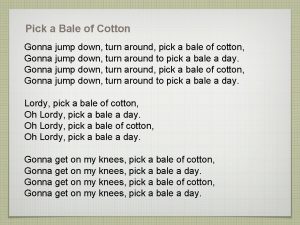DO NOW Pick up notes and Review 5














- Slides: 14

DO NOW Pick up notes and Review #5. Turn in Review #4.

REVIEW What can fossils tell us about the age of the rocks they are found in? If you found a rock with a trilobite fossil, what would you conclude about the age of the rock?

FOSSILS AND PAST ENVIRONMENTS SES 4. Students will understand how rock relationships and fossils are used to reconstruct the Earth’s past. c. Apply the principle of uniformitarianism to relate sedimentary rock associations and their fossils to the environments in which the rocks were deposited.

FOSSILS AND THEIR ENVIRONMENTS Fossils show organisms have changed over time. Can also be useful for telling us about the environment they lived in. The type and distribution of fossils is the best indicator of an area's ancient environmental conditions and climates!

FOSSILS AND THEIR ENVIRONMENTS Clues about their environment include: Comparing to the nearest living relative Adaptations (ex: fins? wings? ) Abundance of certain fossils Plants: Leaf analysis Pollen Tree rings

LIVING RELATIVES AND ADAPTATIONS Appearance: Some fossils look like living organisms. Some fossils are ancestors of living organisms. Structure: Thin-shelled fossils more often live in deep water; thick-shelled fossils are more common in shallow water.

LIVING RELATIVES AND ADAPTATIONS Structure: Corals are typically grow in shallow water. Adaptations: Algae or seaweed would be found in shallow water rocks, because they are photosynthetic and need sunlight to grow.

CLUES FROM PLANTS Usually found on land. Pollen: Abundance – lots? Little? Ratio of pollen types Similar structures and adaptations: Wet regions – large leaves Dry areas – small leaves

CLUES FROM PLANTS Similar structures and adaptations: Pine needles - shape and coating reduces evaporation. Thick coating on leaves (cuticle) protects against water loss. Plants in very windy conditions have a high density of pores (stomata), but are pores are small.

LEAF MARGIN ANALYSIS A way of telling average temperature by looking at the shape of leaves: Warm tropical areas have a higher PERCENT of plants with smooth edges. Cooler environments have a higher PERCENT of plants with leaves with more toothed edges.

LEAF MARGIN ANALYSIS Why? Toothed edges (margins) increases surface area, allows for more transpiration and greater photosynthesis. Colder climates have shorter growing seasons – need greater ability. Warmer climates – same structures lead to dehydration, need less ability.

COMPARISON Greater percentage of smooth leaves = warmer temperatures

REVIEW If 25% of all fossil leaves found in an area are smooth and 75% are toothed, the past climate was most likely about: A. 5°C B. 10°C C. 15°C D. 20°C

Activity: Leaf Margin Analysis – Site A & B Determine average temperature for each site Compare results
 What are pick up notes
What are pick up notes Now i see it now you don't
Now i see it now you don't Testojack reviews
Testojack reviews Cube wisc
Cube wisc Romeo and juliet act 1 prologue
Romeo and juliet act 1 prologue Lines from romeo and juliet
Lines from romeo and juliet Cih waiver
Cih waiver How to write banter
How to write banter Jump down turn around pick a bale of cotton
Jump down turn around pick a bale of cotton Lipid
Lipid Qfocus examples
Qfocus examples Etsu graduation office
Etsu graduation office Phone call phrasal verbs
Phone call phrasal verbs Light fog artifact
Light fog artifact Pick a number wuestions
Pick a number wuestions



























